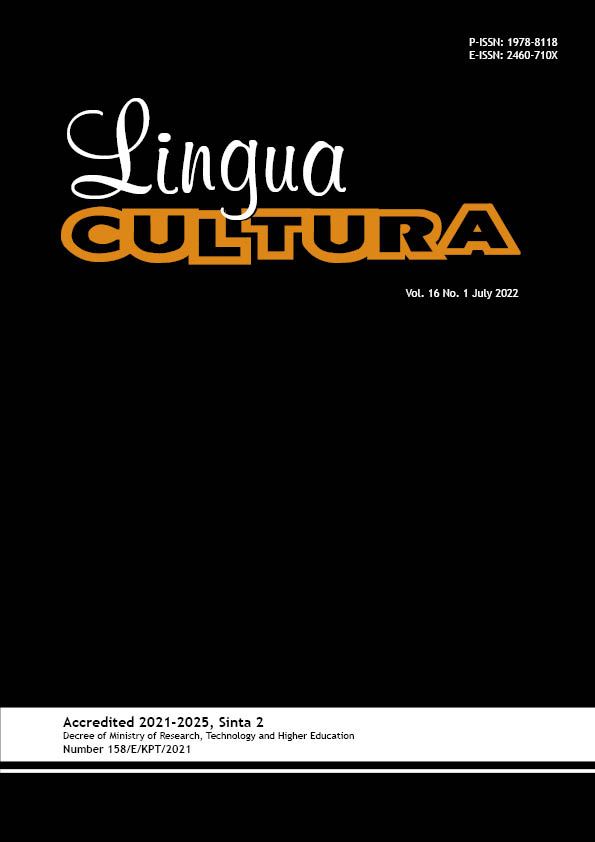Transposition of English Zero Derivation from Nouns to Indonesian Verbs in to Kill a Mockingbird
DOI:
https://doi.org/10.21512/lc.v16i1.7667Keywords:
zero derivation, English conversion, transposition strategy, deverbal noun, noun baseAbstract
The research aimed to discuss and analyze the translation of English zero derivation or conversion from nouns to Indonesian verbs using transposition strategy. The research was carried out through the qualitative method by having the constant comparative analysis whose data were collected from Harper Lee’s novel ‘To Kill a Mockingbird’. The data collection was obtained by sampling to support the description based on the classification, including morphological and syntactic categories. The findings show an obvious difference between source and target languages. This occurs when the translation of English zero derivation relies on the affixes more frequently than any other criteria. Furthermore, the overall result proves that the transposition of English conversion from nouns into Indonesian verbs can be analyzed from the verb base that can be converted into nouns, which is then called a deverbal noun, and the noun base that can be converted into a verb. The translation of English zero deverbal noun is possible to be transposed into the target language verb. In a part of formal properties, the identification of English verb base converted into noun could be characterized by the irregular verb, stress pattern, intransitive verb, and semantic complexity, at the same time when the English noun base is transposed into Indonesian verb by considering the verbal interpretation and frequency of occurrence.
References
Agistiawaty, F. (2019). The analysis of unit shift in the research of translation with commentary: English into Indonesian. Aksara, 31(1), 123-136. https://doi.org/10.29255/aksara.v31i1.316.123-136.
Amarasinghe, H. (2020). Investigation on the influence of transposition as a translation strategy in the field of online journalism in Sri Lanka. AJHSSR: American Journal of Humanities and Social Science Research, 4(10), 145-148.
Anggraeni, P., Mujiyanto, J., & Sofwan, A. (2019). The implementation of transposition translation procedures in English-Indonesian translation of epic movie subtitle. ELT Forum: Journal of English Language Teaching, 7(2), 1-7. https://doi.org/10.15294/elt.v7i2.28850.
Bravo, J. (Ed.). (2021, 17 Dec). Why is communication important in translation? Retrieved on March 9th 2022 from https://www.translateday.com/why-is-communication-important-in translation/.
Dehham, S. H. (2016). The use of English adjectival affixes by Iraqi EFL learners: An error analysis. Sciedu Press: English Linguistics Research, 5(1), 14-31. http://dx.doi.org/10.5430/elr.v5n1p14.
Ekasani, K. A., Yadnya, I. B. P., Artawa, K., & Indrawati, N. L. K. M. (2018). Category shift in the translation of verb phrases in English cookbook into Indonesian. International Journal of Linguistics, Literature, and Translation (IJLLT), 1(4), 73-77. http://dx.doi.org/10.32996/ijllt.2018.1.4.10.
Fikri, Z. (2017). Morphological study on verbal inflectional and derivational process in Sasak language. Journal Ilmiah Rinjani: Media Informasi Ilmiah Universitas Gunung Rinjani, 5(2), 156-163. https://doi.org/10.12345/jir.v5i2.11.
Hardyanti, S., Warigan., & Utami, S. P. T. (2017). Perbandingan afiks pembentuk verba bahasa Indonesia dan bahasa Jawa. Jurnal Sastra Indonesia, 6(1), 34-40.
Haspelmath, M., & Sims, A. D. (2010). Understanding morphology. London, UK: Hodder Education.
Hendrawati, A., & Budiarta, I. W. (2017). The translation of idiomatic expression in bloodline into “Garis Darahâ€. Retorika: Jurnal Ilmu Bahasa, 3(2), 228-238. https://doi.org/10.22225/jr.3.2.295.228-239.
Lee, H. (1960). To kill a mockingbird. New York, USA: Warner Books.
Lee, H. (2008). To kill a mockingbird. Translated by Femmy Syahrani. Bandung: Qanita.
Lurisari, M. (2019). An analysis of translation loss in the “The Jewel Smurferâ€. CaLLs: Journal of Culture, Arts, Literature, and Linguistics, 5(2), 59-69. http://dx.doi.org/10.30872/calls.v5i2.1948.
Mandal, P. C. (2018). Translation in qualitative research with an emphasis on grounded theory. IJHSSR: International Journal of Humanities and Social Science Research, 4(2), 81-85.
Mizher, R. A. (2016). Chesterman’s syntactic strategies in translating English passive voice construction into Arabic. IJCLTS: International Journal of Comparative Literature & Translation Studies, 4(3), 32-43. http://dx.doi.org/10.7575/aiac.ijclts.v.4n.3p.32.
Nugraha, A., Nugroho, M. B., & Rahman, Y. (2017). English–Indonesian translation methods in the story “A Blunder†by Anton Chekhov. Indonesian EFL Journal, 3(1), 79-86. https://doi.org/10.25134/ieflj.v3i1.656.
Plag, I. (2003). Word-formation in English. Cambridge: Cambridge University Press. https://doi.org/10.31294/w.v10i2.3901.
Pratama, S. H. H., & Hartono, R. (2018). Semantic shift in the English-Indonesian translation of Dessen’s “What Happened to Goodbyeâ€. EEJ: English Education Journal, 8(2), 195-207. https://doi.org/10.15294/EEJ.V8I3.21912.
Rahayu, N. W. E. E., Sedeng, I. N., & Indrawati, N. L. K. M. (2020). The syntactic strategies and equivalence of English nonfinite verbs which translated into Indonesian with reference to National Geographic magazine. Linguistika: Buletin Ilmiah Program Magister Linguistik Universitas Udayana, 27(1), 39-47. https://doi.org/10.24843/ling.2020.v27.i01.p05.
Umam, A. H. (2018). Keberterimaan antara teks sumber dan teks sasaran. Wanastra, 10(2), 47-54. http://dx.doi.org/10.31294/w.v10i2.3901.
Tiswaya, W., & Hamid, A. (2019). Transposition of predicate verbals to be subject nouns in Indonesian and Sundanese sentence. Madah: Jurnal Bahasa and Sastra, 10(1), 1-14. http://dx.doi.org/10.31503/madah.v11i1.203.
Vinay, J. P., & Darbelnet, J. (2000). A methodology for translation. London: Routledge.
Downloads
Published
How to Cite
Issue
Section
License
Copyright (c) 2022 Hana Fauziah

This work is licensed under a Creative Commons Attribution-ShareAlike 4.0 International License.
Authors who publish with this journal agree to the following terms:
a. Authors retain copyright and grant the journal right of first publication with the work simultaneously licensed under a Creative Commons Attribution License - Share Alike that allows others to share the work with an acknowledgment of the work's authorship and initial publication in this journal.
b. Authors are able to enter into separate, additional contractual arrangements for the non-exclusive distribution of the journal's published version of the work (e.g., post it to an institutional repository or publish it in a book), with an acknowledgment of its initial publication in this journal.
c. Authors are permitted and encouraged to post their work online (e.g., in institutional repositories or on their website) prior to and during the submission process, as it can lead to productive exchanges, as well as earlier and greater citation of published work.
USER RIGHTS
All articles published Open Access will be immediately and permanently free for everyone to read and download. We are continuously working with our author communities to select the best choice of license options, currently being defined for this journal as follows: Creative Commons Attribution-Share Alike (CC BY-SA)


















